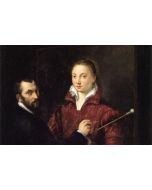Women in art: 1900-1960
This course will be delivered online. See the ‘What is the course about?’ section in course details for more information.

This course has now started
- Course Code: VB554
- Dates: 16/04/24 - 21/05/24
- Time: 10:30 - 12:30
- Taught: Tue, Daytime
- Duration: 6 sessions (over 6 weeks)
- Location: Online
- Tutor: Elizabeth Eyres
Course Code: VB554
Duration: 6 sessions (over 6 weeks)
Please note: We offer a wide variety of financial support to make courses affordable. Just visit our online Help Centre for more information on a range of topics including fees, online learning and FAQs.
What is the course about?
From the beginning of the twentieth century, women artists were able to take a more significant role in the visual arts than at any point in the past. Even though this was still a time when women who moved in avant-garde circles were more likely to be models, “muses” or lovers, some women managed to work at the forefront of key Modernist avant-garde movements such as German Expressionism, Dadaism, Surrealism, Orphism, Vorticism, Rayonism and Constructivism. We shall explore the work of these artists as well as others who were not associated directly with specific movements but nonetheless made vitally important contributions to Modernism and the art world generally, including women who were official war artists and pioneers in abstraction.
We shall discuss the work of artists including Suzanne Valadon, Käthe Kollwitz, Gwen John, Paula Modersohn-Becker, Gabriele Münter, Vanessa Bell, Natalia Goncharova, Sonia Delaunay, Georgia O’Keeffe, Hannah Höch, Dod Proctor, Winifred Nicholson, Tamara de Lempicka, Barbara Hepworth, Eileen Agar, Frida Kahlo, Dorothea Tanning, Meret Oppenheim, Leonora Carrington and others.
This is a live online course. You will need:
- Internet connection. The classes work best with Chrome.
- A computer with microphone and camera is best (e.g. a PC/laptop/iMac/MacBook), or a tablet/iPad/smart phone/iPhone if you don't have a computer.
- Earphones/headphones/speakers.
We will contact you with joining instructions before your course starts.
What will we cover?
• We will examine a wide range of work by European and American women artists working in a wide range of media who both worked at the forefront of the Modernist avant garde art and who worked independently of specific movements
• We will look at cultural and social contexts of the day, and discuss how these artists responded to such contexts and negotiated their way through the male-dominated art world
• We will investigate and discuss how these artists express identity through their work
• You will learn how to analyse the formal features of selected works.
What will I achieve?
By the end of this course you should be able to...
• Name a range of women artists form the period 1900-1950 and identify the areas of the avant-garde they were associated with
• Identify significant art works by these artists and explain their importance
• Explain how contemporary cultural and social issues have affected the work and reputations of these artists
• Analyse the formal qualities of key works.
What level is the course and do I need any particular skills?
This course is suitable for all levels and requires no previous experience or study of the subject.
You should be able to follow simple written and verbal instructions, as well as demonstrations and instructions on the basic elements of Zoom software, like the usage of the microphone and camera.
How will I be taught, and will there be any work outside the class?
You will be taught by lecture with slide images and you will be invited to participate in group discussion.
You will be provided with comprehensive illustrated handouts each week by your tutor to support your learning on the course; these handouts will be available on City Lit’s Google Classroom rather than being printed out for you. Each week there will be suggestions of optional follow-up reading and videos that you can watch online to supplement the class, but no formal homework is set.
Are there any other costs? Is there anything I need to bring?
You might wish to purchase a notebook for taking notes. You might wish to buy some of the books on any reading list provided.
When I've finished, what course can I do next?
Modern Art: movements 1900-1950
Women in Art 1400-1800
Women in Art 1800-1900.
Liz Keevill Eyres worked as a textile designer in the fashion industry for four years and then as a magazine journalist specializing in interior design for 13 years. Her first degree was at Camberwell School of Art which she did at the same time as completing a degree in History and Art History with the Open University. Liz studied and has taught at Kingston University, where she lead modules and lectured in history of art, design history and architecture for ten years and ran study visits both at home and abroad. Liz has researched into English Modernist textile design of the 1950s and the professional practice of the provincial Edwardian architect, in particular Norwich-based architect George Skipper.
Please note: We reserve the right to change our tutors from those advertised. This happens rarely, but if it does, we are unable to refund fees due to this. Our tutors may have different teaching styles; however we guarantee a consistent quality of teaching in all our courses.
